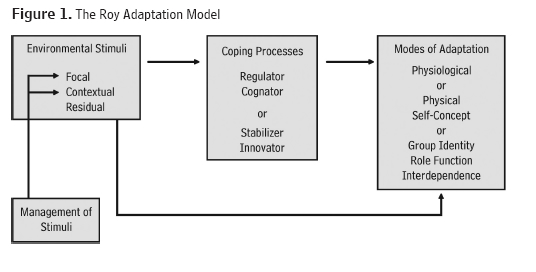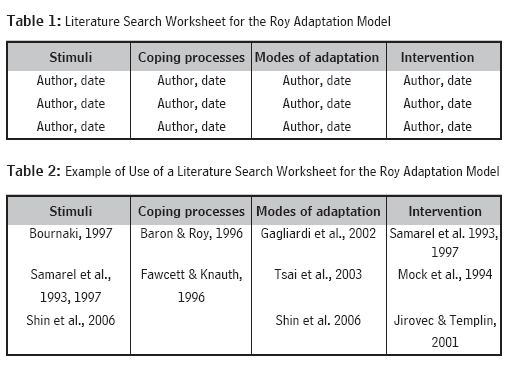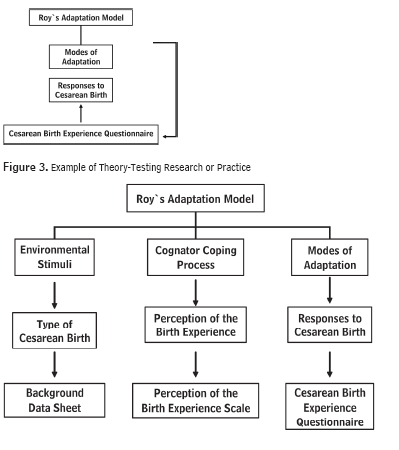
Using the Roy Adaptation Model to Guide Research and/or Practice: Construction of Conceptual- Theoretical-Empirical Systems of Knowledge
Recibido: 26 de agosto de 2009
Aceptado: 2 de noviembre de 2009
Jacqueline Fawcett1
1 Professor, College of Nursing and Health Sciences. University of Massachusetts. Boston, USA. jacqueline.fawcett@umb.edu
ABSTRACT
This paper presents an explanation of a three-step process for the use of a conceptual model to guide nursing research and/or practice. Step 1 involves learning the content of the conceptual model and its research and practice guidelines. Step 2 requires a review of literature about the use of the model as a basis for research or practice. Step 3 focuses on construction and communication of a conceptual- theoretical-empirical structure for diverse research topics and practice situations. Emphasis is placed on application of the process to one conceptual model of nursing: the Roy Adaptation Model.
KEY WORDS
Roy Adaptation Model, research, practice, nursing. (Source: DeCs, BIREME).
Uso del Modelo de Adaptación de Roy para guía de la investigación y/o la práctica: construcción de sistemas de conocimiento conceptuales-teóricos-empíricos
RESUMEN
Este artículo presenta una explicación para un proceso de tres pasos sobre el uso de un modelo conceptual para guía de la investigación y/o la práctica de la enfermería. El paso 1 implica el conocimiento del modelo conceptual y sus directrices para la investigación y la práctica. El paso 2 exige una revisión de la literatura sobre el uso del modelo como base para la investigación o la práctica. El paso 3 se enfoca en la construcción y la comunicación de una estructura conceptual – teórica – empírica sobre los diversos temas de investigación y las situaciones de práctica. El énfasis se hace sobre la aplicación del proceso a un modelo conceptual de enfermería: el Modelo de Adaptación de Roy.
PALABRAS CLAVE
Modelo de Adaptación de Roy, investigación, práctica, enfermería. (Fuente: DeCs, BIREME).
Aplicação do Modelo de Adaptação de Roy na pesquisa o na prática: construção de sistemas de conhecimento conceptual e teórico-empírico
RESUMO
Este artigo oferece uma explicação para um processo de três passos sobre o uso de um modelo conceitual para orientar a pesquisa ou a prática de enfermagem. O passo 1 implica um conhecimento do modelo conceptual e suas diretrizes para a pesquisa e a prática. O passo 2 requer uma revisão da literatura sobre a utilização do modelo como base para a investigação ou a prática. O passo 3 centra-se na construção e a comunicação de um quadro conceptual e teórico-empírico sobre temas de investigação e várias situações de prática. Aênfase está na aplicação do processo em um modelo conceitual de enfermagem: o Modelo de Adaptação de Roy.
PALAVRAS-CHAVE
Modelo de Adaptação de Roy, investigação, práctica, enfermagem. (Fonte: DeCs, BIREME).
Introduction
The purpose of this paper is to present an explanation of three steps that need to be followed to use a conceptual model to guide nursing research and/or practice. The content of the paper reflects my belief that it is impossible to conduct nursing research or to practice nursing without guidance from a conceptual model. Indeed, Popper (1) pointed out that it is “absurd” (p. 46) to assume that development of any theory can occur without guidance from a conceptual model. The paper content also reflects my beliefs that the product of research always is a theory, and that nursing practice should be guided by nursing theories that are derived from nursing conceptual models.
Steps to Follow to Use a Conceptual Model to Guide Nursing Research and/or Practice
The use of a conceptual model to guide research and/or practice involves a process made up of three steps (2). The three steps are listed here.
1. Develop a comprehensive understanding of the content and the research and practice guidelines of the conceptual model.
2. Review existing research and practice guided by the conceptual model.
3. Construct and clearly communicate a conceptual-theoretical-empirical structure.
Step 1: Conceptual Model Content and Guidelines for Research and Practice The first step of the process of using a conceptual model to guide nursing research and/or practice is to understand the content of the conceptual model and to read carefully the guidelines for research and the guidelines for practice (2). A conceptual model is made up of abstract and general concepts and statements about those concepts (3). The content of the Roy Adaptation Model, for example, is made up of such abstract concepts as environmental stimuli, coping processes, and modes of adaptation; the statements that broadly define each concept; and the statements that link the concepts (see Figure 1). A narrative summary of the Roy Adaptation Model is given in Box 1.

Box 1. Narrative Summary of the Roy Adaptation Model
Within the context of the Roy Adaptation Model, individuals and groups are regarded as adaptive systems whose behavior is a response to environmental timuli (4). Roy (4) identified three types of environmental stimuli--focal, contextual, and residual—that she regards as constantly changing forces that affect individuals and groups. The focal stimulus is the one most immediately confronting an individual or a group. The contextual stimuli are all other stimuli that contribute directly to the individual’s or the group’s responses. Residual stimuli are unknown factors that may be affecting the individual or group. When a residual stimulus is identified, it usually becomes a contextual stimulus but may turn out to be the focal stimulus. Environmental stimuli are directly related to coping processes (4) and both directly and indirectly related to the modes of adaptation (5). The indirect elation between environment stimuli and the modes of adaptation is mediated by the coping processes Individuals use two coping processes to filter nvironmental stimuli, which are called the regulator and the cognator. The regulator coping process encompasses basic neural, chemical, and endocrine channels that process stimuli in an automatic, unconscious manner. The cognator coping process encompasses four cognitive-emotive channels for stimulus processing--perceptual/information processing, learning, judgment, and emotion. Groups use two different coping processes to filter environmental stimuli, which are called the stabilizer and the innovator. The stabilizer coping process facilitates accomplishment of the purpose for which the group was formed, through use of the group’s structure, values, and usual activities. The innovator coping process focuses on the mechanisms by which the group changes and grows. Roy (4) identified four modes of adaptation, which are the ways in which responses
to environmental stimuli are expressed in people’s behavior. The physiological mode
of adaptation incorporates individuals’ biological behaviors, such as vital signs and
clinical laboratory values. The physical mode of adaptation focuses on needs of the
group for the basic resources needed to function. The self-concept mode of adaptation
incorporates individuals’ feelings about their bodies and their personal selves.
The group identity mode of adaptation focuses on how the members of a group view
themselves. The role function mode of adaptation draws attention to both individuals’
and groups’ performance of activities associated with the roles they enact in society. Roy Adaptation Model-based nursing interventions involve management of the environmental stimuli. Roy (4) recommends focusing on managing the focal stimulus, taking the contextual stimuli into account. |
Fawcett (3) identified guidelines for nursing research and guidelines for nursing practice based on the Roy Adaptation Model. The guidelines for research are listed here (3, pp. 385-396).
The guidelines for practice are listed here (3, p. 388).
The broad purpose of Roy Adaptation Model–based nursing practice is to promote the ability of human adaptive systems to adjust effectively to changes in the environment and also to create changes in the environment.
Step 2: Review of Literature The second step in the process of using a conceptual model to guide research and/or practice is to search and critically review the literature about the research topic or practice situation (2). The concepts of the conceptual model can be used as the basis for search terms and to categorize the results of the literature search.
The Cumulative Index to Nursing and Allied Health Literature (CINAHL) is an excellent electronic database for searches of literature about nursing conceptual models. For example, a CINAHL search term is Roy Adaptation Model. That search term can be combined with the search term, research, as well as with one or more search terms that reflect the specific research topic or practice situation. Suppose, for example, you are interested in studying women’s responses to cesarean birth. Combining the search terms, Roy Adaptation Model, research, and cesarean, will yield relevant literature. Or, suppose you are interested in the postpartum care of women who have had a cesarean delivery. Literature that is relevant for this practice situation can be obtained by combining the search terms, Roy Adaptation Model, practice, postpartum, and cesarean.
The citations to literature that are obtained from the search of the database can be retrieved, reviewed for relevance, and then categorized using the concepts of the conceptual model. A worksheet that can be used to organize literature about the Roy Adaptation Model is shown in Table 1. An example of use of the worksheet is given in Table 2.

Step 3: Construct and Communicate the Conceptual-Theoretical-Empirical Structure
The third step in the process of using a conceptual model to guide research and/or practice requires the construction of a conceptual-theoretical-empirical (CTE) structure and communication of that structure in a diagram and a narrative (2). The components of a CTE are the conceptual model (C) that is the basis for the research topic or practice situation, the theory (T) that is to be generated or tested, and the empirical indicators (E) that provide a way to directly observe the theory.
Recall that the definition of a conceptual model—the C component—is a set of abstract and general concepts and statements about those concepts. The concepts and statements that make up a conceptual model are too broad to be used directly in research or practice. Instead, theories— the T component - are derived from the conceptual model and then are translated into empirical indicators—the E component.
A theory is made up of relatively specific and concrete concepts and statements about the concepts (3). For example, a theory of adaptation to cesarean birth, which was derived from the Roy Adaptation Model, is made up of three concepts— type of cesarean birth (planned or unplanned), perception of the birth experience, and responses to cesarean birth, as well as the definition of each concept and three statements linking the concepts. The type of cesarean birth is directly related to responses to childbirth, perception of the birth experience is related to responses to cesarean birth, and the indirect relation between the type of cesarean birth and responses to cesarean birth is mediated by perception of the birth experience (6).
An empirical indicator is a very concrete
and specific substitute for a theory
concept that allows the concept to be measured
for research purposes or observed in
practice situations (3). For example, perception
of the birth experience can be measured
by the Perception of Birth Experience Scale
(POBES), and responses to cesarean birth
can be measured by the Cesarean Birth
Experience Questionnaire (CBEQ). Many
empirical indicators, including the POBES
and the CBEQ, can be used as research instruments
and as practice tools (7).
Inductive Reasoning: Theory-Generating Research
The CTE structure for theory-generating research is constructed inductively, proceeding from the conceptual model to the empirical indicators to the theory. An example of a CTE structure for a Roy Adaptation Model-guided theory-generating study is shown in Figure 2.
Deductive Reasoning: Theory-Testing Research and Practice
In contrast, the CTE structure for theory-testing research and/or for practice is constructed deductively, proceeding from the conceptual model to the theory to the empirical indicators. An example of a CTE structure for a Roy Adaptation Modelguided theory-testing study or practice situation is shown in Figure 3. Inasmuch as theory-testing research and practice are essentially the same process, the CTE structure is the same. This means that the research process and the nursing practice process are equivalent processes (7). For example, the statement of the problem in research is the same as the assessment phase of the nursing practice process, and conduct of the research is the same as the intervention phase of the nursing practice process.
Figure 2. Example of Theory-Generating Research

Narrative Description of the CTE Structure
Figures 2 and 3 are diagrams of CTE structures. The narrative that accompanies the diagrams should clearly communicate what is illustrated in the diagram. Clear communication can be accomplished by following the directions given here.
For theory-generating research and for theory-testing research and/or practice, follow these directions:
An example of the application of these directions is seen in Box 1, which contains the name of a conceptual model – the Roy Adaptation Model in this example – and a narrative summary of the content of that conceptual model.
For theory-generating research, also follow these directions:
An example of the application of these directions is seen in Box 2, which provides the narrative for the CTE structure illustrated in Figure 2.
Box 2. Narrative for the Conceptual-Theoretical-Empirical Structure Illustrated in Figure 2.
The Roy Adaptation Model concept of modes of adaptation guided construction of the Cesarean Birth Experience Questionnaire (CBEQ). Content analysis of the data obtained from study participants, who provided answers to the open-ended questions on the CBEQ, revealed the Theory of Responses to esarean Birth. The Theory of Responses to Cesarean Birth is made up of the concept of cesarean birth responses, which is defined as physical feelings, feelings about self, feelings about delivering by cesarean section, and feelings about the infant and other family members. |
For theory-testing research and/or practice, also follow these directions:
State the linkages between the conceptual model concepts and the theory concepts--Conceptual model concept A is represented by theory concepta. Conceptual model concept B is represented by theory concept. …Conceptual model conceptN is represented by theory concept.
Box 3. Narrative for the Conceptual-Theoretical-Empirical Structure Illustrated in Figure 3.
The Roy Adaptation Model concept of environmental stimuli is represented by the theory concept of type of cesarean birth, which is defined as planned or unplanned cesarean delivery, as measured by an item on the Background Data Sheet. The Roy Adaptation Model concept of the cognator coping processes is represented by the theory concept of perception of the birth experience, defined as feelings about labor or preoperative procedures, delivery, and initial contact with the infant, as measured by the Perception of Birth Experience Scale. The Roy Adaptation Model concept of modes of adaptation is represented by the theory concept of responses to cesarean birth, which is defined as women’s responses to the events surrounding cesarean childbirth, as measured by a numerical score based on answers to open-ended questions on the Cesarean Birth Experience Questionnaire. |
Conclusion
When conceptual model guided theory- testing research and/or practice are regarded as equivalent processes, the contributions made by both researchers and practicing nurses to theory development become obvious. However, the contributions will remain unrecognized if the work is not clearly communicated to others. The use of a conceptual model to guide nursing research and/or practice sometimes seems very complicated. However, following the three-step process (Box 4) that is explained in this paper can simplify thinking about and communicating how you are using a conceptual model to guide your research and/or practice.
Box 4. The Three-Step Process for Using a Conceptual Model to Guide Nursing Research and/or Practice.
Develop a comprehensive understanding of the content and the research and practice guidelines of the conceptual model. Review existing research and practice guided by the conceptual model. Construct and clearly communicate a conceptual-theoretical-empirical structure. |
REFERENCES 1. Popper KR. Conjectures and Refutations. City (State): publisher, 1965. 2. Fawcett J, E Gigliotti. Using Conceptual Models of Nursing to Guide Nursing Research: The Case of the Neuman Systems Model. Nurs Sci Quarterly 2001; 14(4): 339-45. 3. Fawcett J. Contemporary Nursing Knowledge: Analysis and Evaluation of Nursing Models and Theories. 2 ed. Philadelphia (PA): FA Davis Company; 2005. 4. Roy C. The Roy Adaptation Model. 3 ed. Upper Saddle River (NJ): Pearson Education; 2009. 5. Fawcett J. The Roy Adaptation Model. Japanese J Nurs Res 2003; 36(2): 67-73. 6. Fawcett J, S.T. Myers, J.L. Hall, and L. Waters. Women’s Adaptation to Cesarean Birth: Oklahoma Site. In: Fawcett J, Garity, J. Evaluating Research for Evidence-based Nursing Practice. Philadelphia (PA): FA Davis Company, 2009; on book CD. 7. Fawcett J, Garity J. Evaluating Research for Evidence- based Nursing Practice. Philadelphia (PA): FA Davis Company; 2009. |